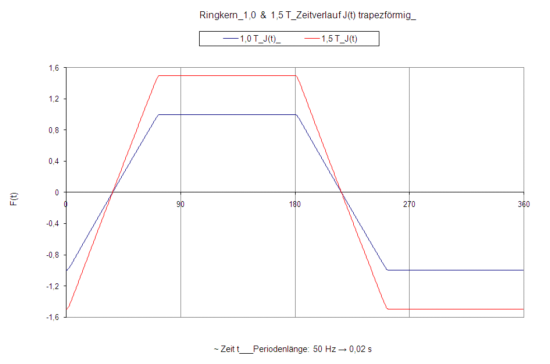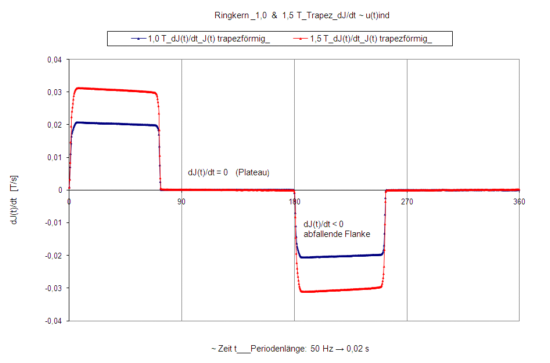Magnetic measurements for the optimisation of the magnetic circuits of three-phase machines
Measuring program
For the optimisation of the magnetic circuits of high performance three-phase synchronous machines and three-phase asynchronous machines in co-operation with a manufacturer
- EPSTEIN specimens
- toroidal core specimens
were examined.
The measurements imply the determination
- of the hysteresis losses P(J)Hyst. in a quasi-static field
- of the magnetisation characteristics J(H) to Hmax ≈ 30,000A/m dependent on frequency
- of the specific total losses P(J) on the frequencies 50 – 60 – 150 – 180 – 250 – 300 – 350 – 420Hz
The specific total losses P(J) were determined
- at a sinusoidal curve shape J(t) = J^*sinωt of the polarisation
- at a trapezoidal curve shape of the polarisation J(t)
- at further curve shapes of the polarisation J(t).
Ergebnisse (Auswahl)
Magnetisation characteristic curves J(H)
As expected the J(H)-characteristics of the EPSTEIN-specimens differ from those of the toroidal core specimens in the range below the knee of the curves.

As shown in the diagram the J(H)-characteristics do not depend
- on the shape of the specimen
- on the frequency f
for measured values J > 1.50T.
Characteristic curves of the total losses P(J)
Main points of these measurements were the determination of curves of the total losses P(J, f)
- dependent on frequency
- dependent on different time functions of the polarization J(t) resp. the flux density B(t)
There were different P(J)-characteristics for the EPSTEIN and the core specimens.
The client was interested in the characteristic curves P(J) for J > 1.50T.
Loss measurements with trapezoidal polarisation J(t)
The transmissibility of the measured loss values P(J) to the magnetic circuits in the electrical machines is problematic. So the sinusoidal curve shape J(t) = J^*sin(ωt) of the polarization, given by the standard for measurements of the total losses, in general is not characteristically for the operation conditions in electrical machines.
For this reason the losses P(J) were additionally measured with non-sinusoidal time functions of the polarisation J(t). The investigations are described by an example of a loss measurement with a trapezoidal polarisation J(t).


For the trapezoidal time function of the polarisation J(t)
- the flanks with a constant rise dΦ/dt ~ dJ (t)/dt ≈ const.
- the plateau with J = J^ = const. and with a rise dΦ/dt ~ dJ (t)/dt = 0
are characteristic.
The changes of the magnetic state occur in the trailing and the rising edges, the losses depend on the rises dJ (t)/dt.
The time periods
- with dynamic magnetisation (hysteresis – & eddy current losses)
- with static magnetisation (eddy current losses)
can be separately evaluated.
Both the measured magnetisation characteristics J(H) as well as the loss characteristics P(J) could be very well mathematically described.
In co-operation with an engine manufacturer
– the J(H)-magnetisation characteristics
– the P(J)-loss characteristics
of the used electrical steel were determined.
Specimens were EPSTEIN-strips and toroidal cores.
The magnetisation conditions in the cores of the E-machines were approximated by variation of the measuring parameters.
The magnetic characteristic functions J(H) and P(J), which were finally formulated, agreed very well with the results of the measurements.